|
By Jennifer Heidersdorf 4th Grade, Mendenhall River Community School Student Thinking about this image: What do you see? I see sand and mountains. I see an arch. I see a rocks and a canyon with a hole. I see sandstone, orange. I see a rock with a hole in it. What do you think? I think it’s a desert. I think it has reptiles. I think the sun is going down. I think there’s a cave. I think the picture was taken in Arizona. I think there’s very little water. I think it’s really old. I think the rock eroded What do you wonder? I wonder if it’s a hot place. I wonder if it’s a canyon. I wonder if the shrubs are grass and if the arch will fall. I wonder where this picture was taken. I wonder if sand made the hole. I wonder if things got fossilized in the rocks. I wonder if there’s a road or cactus there. I wonder what’s beyond the rock. I wonder how it was created. While attending the NSTA Conference this spring and learning with other teachers on how to implement the NGSS (Next Generation Science Standards), I got excited and thought, "wow, this sounds a lot like the Artful Thinking routine of See/Think/Wonder". We ultimately want all students to observe things, think about why things work, and ask questions that will hopefully lead them to future investigations to find the answers. Presenting students with a phenomenon in the form of pictures or other media creates an opportunity for students to look with their eyes wide open and share their ideas in a safe, nonjudgmental environment. This approach has become a common practice in the way that I start many of my lessons in my fourth grade class. For this opening science lesson, I wanted students to view a variety of images while doing a See/Think/Wonder routine. As we went through these slides, I had students respond aloud and also in written form. I didn’t frontload the lesson or give students any more information then that; my hope was that it would lead to them asking questions and that they would find a common occurrence among the pictures. Students were eager to share and had a wide range of responses and questions. When we finished looking at the images the first time, I asked them to take a quick look at the slides again and see if they noticed a common occurrence happening within the images. I love the engagement of students when they talk about what they’re seeing, thinking, and wondering. By separating out the questions, the routine stimulates curiosity and helps students reach for new connections. I could see from the student responses that they had a deeper interest. Student Thinking about this image: What do you see? I see sand and mountains in the background. I see a big hole in the the standing rock. I see a rock that looks like a hand without fingers. I see a statue of the illuminati. What do you think? I think it’s in the middle of nowhere. I think wind carved the rock. I think something hides or gets in the shade in the big rock. I think there’s water. I think it’s 10,000 years old. I think the rock is not stable and it might fall. What do you wonder? I wonder if people live there. I wonder if the rock is going to fall. I wonder if it was flooded and then got dried out. I wonder what’s behind the rock. I wonder if I can fit in the rock. I wonder if somebody sculpted the rock. I wonder where this is. I wonder how it came to be. Student Thinking about this image: What do you see? I see a cliff holding a building. I see the tide has gone down. I see what would be the ocean. I see wet rocks, seaweed, and blue sky. What do you think? I think it was hard to get down to the beach. I think they’re going to rebuild the house. I think it’s in a foreign country. I wonder if the person taking the picture is underwater. I think there was war before the house was built. I think people would go there on the 4th of July. What do you wonder? “I wonder where the photo was taken. I wonder if I’ve seen it before. I wonder if there was a tsunami. I wonder if the house was a church. I wonder if the water wore the cliff down. I wonder what the people are doing. I wonder how long the building has been there.” Engagement and Enthusiasm What I love is hearing students make connections and but having them make those connections on their own. I didn’t want to give students any vocabulary, I just restated what they said and eventually a student said the word erosion. At that point I asked him what he meant by that and then we were able to substitute that word with a definition that tied into what they were observing but they made the connection on their own. From this point we talked about the different forms of erosion and how it can cause change. Science activities that followed: These lessons served as an entry point into NGSS standards 4-ESS1-1 (Identify evidence from patterns in rock formations and fossils in rock layers for changes in a landscape over time to support an explanation for changes in a landscape over time) and ESS1.C (Local, regional, and global patterns of rock formations reveal changes over time due to earth forces, such as earthquakes). To engage students in the topic of weathering the next day, I presented the class with a picture of an interesting rock formation and gave them the following prompt: With your whiteboard, please use sentences, labels, and drawings to propose an explanation for how you think this rock might have been hollowed out. Please explain how you think this occurred using sentences and drawings. Our Four Investigations Wind: Student groups are provided a container of sand and a drinking straw. Students then blow gently across the sand with the straw. The students are able to see the changes in the sand surface and observe the moving sediment. Students must wear goggles when working with sand. Moving Water: Each group is given a water bottle half-full with water. They then place a piece of chalk in the water and take turns shaking the bottle (moving the water). The students stop after three minutes and make observations. Ice: Students look at a picture (or a real example) of a bottle that was filled with water and then frozen. They can observe the expanded ice sticking out from the top of the bottle and the overexpanded bottle. Living Things: Students are given a baggy with a cracker in it. The cracker represents a rock. Students use their fingers to “weather” the cracker Students then worked in groups of five to propose explanations on a large sheet of paper that had been folded into four sections. I walked from group to group and asked clarifying questions about the science content on the boards (“Can you be more explicit in your drawing about how you think this occurs?”) and about the students’ writing (“Can you label your drawings and add more details using scientific words to explain your drawings?”). I then explained that I wanted each group to come to the front of the classroom, one group at a time, to present their ideas. But, before the first group came up, I directed the students’ attention to a poster on the classroom wall that outlines the group sharing norms that the class developed earlier in the school year. The list contains items such as: • Examine each paper carefully for words and drawings. • Can you identify claims and evidence? • What questions can you ask? • How does your paper compare to other papers? As I reflect on these lessons, I see how important it is for my students to be able to explain their thinking with drawings and explanations. As students observed the connections that other students made, many had some realizations that their paper didn’t look anything like other students papers. I wanted students to have a range of connections but well thought out connections. This is something that students have to practice at, it definitely does not come easy. I plan to start this strategy much earlier in the year next year to see just how much students improve and grow through the year.
0 Comments
By Allison Smith 1st Grade, Auke Bay School Artful Teaching has transformed the way I teach. One example is when we studied weather this year. In the past, when we studied about wind, students made wind flags measure the wind on a scale of 0-2. The flags are made from fabric and cardboard cut for them ahead of time. The emphasis in this lesson had been on the measurement of wind, not so much on the creation of the wind flag. This year I decided to use Artful Teaching to introduce the concept of wind and measuring wind by showing my first grade students different paintings showing wind and wind gauges. That got me thinking...if students are looking at pictures of different wind gauges, why not have them design and create their own wind gauges and test them? What started with me looking for images to introduce a lesson turned into a great STEM project for my students. First I asked students to See, Think, and Wonder looking at 4 paintings showing wind at the same time. Then I asked them to think about what was the same about all of the paintings. “It’s windy!” Was the common answer. Students then talked in small groups about how they knew it was windy. “The curtains are blowing.” "The horses’ manes and tails are blowing.” “The person is flying a kite.” Are a few of the things they shared. Our next step was to work in small groups to look at pictures of different tools designed to measure the wind. I explained to students that we would be looking at these wind gauges and asked them to discuss how they thought they worked. The conversation was lively with lots of pointing at parts of the pictures to explain how they worked. After students had a chance to look at and discuss how the wind gauges worked, I gave them the challenge of creating their own wind gauge by making a plan, building their wind gauge, testing their wind gauge using a fan, and revamping their wind gauge as necessary. It was an amazing process to watch and be a part of. Students were engaged in all parts of the project, taking time to create their designs as well as testing, revamping, and testing their gauges again. After our wind gauges had been tested and redesigned, students took them outside to measure the wind speed on a scale of 0-2. The student created wind gauges worked just as well as the flags we used to make! At the end of the project, I asked students to share what they learned. Here’s what stuck with me:
“If your wind gauge doesn’t work at first, change it and try again.” In the end, this lesson was just as much about the design and creation process as it was weather. Thank you Artful Teaching for expanding my horizons! by Carly Lehnhart Glacier Valley Elementary, 2nd grade Artful Thinking has become such a natural part of my teaching. I have found that it sneaks its way into everything. I continue to be amazed at the engagement and effort that my students put in during and after a Thinking Routine. It brings the focus back to the process and emphasizes curiosity and critical thinking skills, which are two things that I strive to facilitate. One way in which Artful Thinking has made a huge impact for me and my students is in science. I have always used science notebooks as a way of recording our observations and findings, but this year, they have been a lot more successful. I am realizing that Artful Thinking is what I have to thank for that. My students are structuring their observations and notes in ways that are mirroring and combining a lot of the routines that we have tried. Without leading them in a formal routine, I find that they are using the language that has been modeled when they make notes in their science notebooks. Woohoo! I have been loving using Artful Thinking as an introduction to a unit to spark interest and identify our background knowledge, as well as at the end of units as assessments. This specific lesson was kind of in the middle. My students had just been to DIPAC to learn about mollusks. They had been introduced to what a clam was, gotten to see one, and had an overview of the parts. A couple of days later, a parent showed up in the morning with a bucket full of clams and asked if I wanted to use them. I obviously threw out the old plans and quickly came up with an idea of how to use them in my classroom. Artful Thinking immediately came to mind. I started out with a See/ Think /Wonder with this picture. This is a routine that we do A LOT.
I started the lesson doing a Looking 10 x 2 Thinking Routine. They immediately forgot about the picture, because a live clam on your table is way more interesting.
1st look: Quick and simple. They had about 3 minutes to write down words, phrases, or sentences about the clam in front of them. Some second graders struggled with this, so it turned out to be more like 5x2 for some. Here is an example of one students 1st look:
by Elisabeth Hauser, Harborview Elementary, Kindergarten Introducing kindergartners to sea week may be one of the best reasons to be a kindergarten teacher. There’s something that amounts to pure joy in uncovering a huge group of sea urchins under a rock, or the slippery curvy movements of a prickle back with children for the first time. Our time at the beach was amazing! We made so many discoveries and were able to use important property words to describe their physical characteristics. We used our observational skills to notice animal movement and interaction with their environment (and ourselves). In coming back into the classroom, I wanted to see what my children had learned and how they could represent this new knowledge to each other. And so I gave them a challenge: We’ve practiced our acting skills throughout the year with guest actors and individual “tableau” to help us represent characters in some of the books we’ve read. We’ve used the phrase “actor’s neutral” to control our bodies before acting. We’re familiar with the concept and role of an audience. So we’ve had some preparation already. For this tableau experience, our goal was three fold:
Before giving children their group assignments or photo, I modeled a performance with a parent helper in the classroom. My emphasis was on teamwork and kindness during practices, as this was certainly a piece I was worried about as a kindergarten teacher. I placed children into small groups of 2 or 3 children with an animal assignment (which included a familiar photo of the tide pool animal), giving groups 10 minutes to practice and rehearse their role. Then, it was time to perform. Each group’s performance began in the “actor’s neutral” stance. This gave them an opportunity to check their bodies and also gave the audience an indication that they were ready to begin (and, truly, we kind of need to have “audience neutral” at times in kindergarten!). Students were in control, had a plan, and really thought through the movement (or lack of movement). What I loved most was the response of the audience. Students were enraptured because the act was also a game for them – their job was to try and guess what the tide pool animal was. I encouraged children from the audience to explain what clues brought them to their conclusion. It demanded that children look for details in the performance – like the squirt from a clam or the small spikes on top of a still sea urchin. OK, fine, I loved a lot about this experience. So I’ll just mention the other really important piece – the children were elated. They loved working with each other! Learning should be a joyous experience, no matter the age (but goodness it is so important for young children). They should be working together, creating together, and learning together. This year of focused arts integration has been such an important reminder to me of what young children are capable of if they are given the right amount of guidance, modeling, and opportunities (for mistakes and successes!). And, that it’s ok for me, as the teacher, to take risks and make few mistakes along the way to find those joyous and meaningful successes.
by Davin Savikko Riverbend Elementary, Kindergarten I will share the story of how I used the SEE/THINK/WONDER routine when I brought 6 salmon into my kindergarten class. I love this routine for its simplicity: What do you see? What do you think you know (in this case about salmon)? And what does this make you wonder? This routine is a great way to get my students more engaged with a piece of art – or in this case – a topic (salmon). I started out by laying a number of salmon (both Pink and King) around the room on tables. Actually, I started by giving my kids a direct order: “You can’t say ‘Ew!’ – you have to say, ‘Cool’– or something like that." (Unfortunately, that order was not as successful as the use of the SEE/THINK/WONDER routine…but it was pretty funny to hear the kids continually saying ‘Ew!’ and then have 20 other kids yell at them not to say that). Kids were then encouraged to move throughout the room to touch, draw and talk about what they see/notice about the salmon. We then regrouped at the front of the room and I posed the question “What do you think you know about salmon?”. I recorded the kids thinking on butcher paper. The kid’s thoughts ranged in complexity – from simple thoughts and details: “I think tails help fish swim” and “If they don’t live in water they will die” To more in depth details: “The fin right here (points to gills) helps the salmon breathe” and “I think they (salmon) have slime on them so if they go in a seal’s mouth they can slip right out”. That is another thing I really like about using this thinking routine – it allows for multiple entry points for kids depending on their observational skills and/or prior knowledge. Some of the ‘thinking’ was very literal about what they saw from the salmon in the room: “King salmon have dots on their bodies” and other ‘thinking’ obviously came from prior knowledge the student had come in with “You can only keep a King Salmon if it’s size is big enough”. The student’s comments would often build off the comments of their peers. Sometimes it would directly contradict what a classmate had just stated – for instance, right after the claim about the gills helping a fish breathe, another student made the claim: “I think that that fin (points to rear fin) goes under their body and helps it breathe”. All thoughts were recorded by me, word for word, with no corrections or judgements. I then took a different piece of butcher paper and posed the question, “What do you wonder about salmon?” Like the “I think I know” process, some of the wonderings were related to what the students actually observed from the salmon in the room, while others were from prior knowledge or wonderings in general. “I wonder what that little fin on top does?” “I wonder how salmon can breathe under water?” “I wonder how old fish are?” After all the ‘Wonderings’ were recorded I grouped the students around me for the dissection of a few salmon. It was only at this time did I reveal/deliver any of information about salmon – a good 30 minutes into the lesson. All previous talk had been strictly kid generated. Every student in my class was engaged. How often can I say that?
The dissected salmon were then put back on tables and students were encouraged to engage in the same process we used to start the routine – touching, talking and drawing what they saw. by Maura Selenak Harborview Elementary, Kindergarten I learned a routine called Pass the Portrait at a recent inservice with Melanie Rick, an instructor from the Kennedy Center for the Performing Arts. To play Pass the Portrait, students are seated in a circle, facing a partner. Before beginning, students must show the place between them where they will be placing the piece of art (this is an important step because it helps avoid conflicts). In the game, students are taught how to “read” a portrait by discussing things like facial expression, gesture, and focal point. The teacher places a printed portrait in the predesignated spot between each pair of students. The students have one minute to discuss the picture before the teacher starts counting down aloud- “10, 9, 8, 7, 6, 5, 4, 3, 2, 1, pass….the….portrait….!” The expectation is that students will wrap up their discussion by the time the teacher gets to 1, then will pass the portrait to the next pair by the time she finishes saying “pass the portrait”. The teacher moves amongst the students during the discussions, pulling out ideas and writing them on the board to reference later. This routine quickly gets students engaged- there is art in their hands!- and discussing with one another. I used Pass the Portrait to teach my kindergartners the routine and expectations for the game- they are seated, they are talking in quiet voices, they are expected to work with anyone in the class, they finish their conversation by the time I get to 1, and they pass the portrait clockwise. After teaching them this routine, I realized the sky was the limit! For example, we used the routine at the beginning of the Ray Troll art kit. I printed out 15 images of Ray Troll Fish. We began the lesson by looking at one piece of exemplar art on the board and identified colors, lines, patterns, and shapes. We were then ready to play “Pass the Artwork”. We used the exact same routine as Pass the Portrait, except students were looking at Ray Troll images, and they were picking out colors, lines, patterns, and shapes. The discussions were rich, and when it came time for students to create their own artwork, they were inspired and had concrete ideas of what kinds of lines, shapes, colors, and patterns they could use. In another instance, I used the Pass the Portrait routine at the beginning of the Rainbow Flower Garden Art Kit. The kit comes with many colorful artificial flowers. We used used exemplar art to identify flower parts before students played “Pass the Flower” with the artificial flowers. The objective for their discussions during Pass the Flower was to identify flower parts (stem, leaves, flower) and describe the flower (it has 5 petals, it is colorful, it has one long green leaf, etc.)
by Joanna Hinderberger Gastineau School, 1st Grade Before going into one of my Artful Teaching lessons, I want to take a moment to admit how impressed I am with this new way of teaching. As I started integrating Artful Teaching into my practice, I realized how important, yet basic and easy it is to do. Honestly, I must admit that I am a little shocked that I have not always taught this way. I had completely overlooked the importance of explicitly teaching kids how to think. I expected this to be a skill that kids would just know what to do when I said, “think about it.” Now, I have learned that by giving my students the tools they need to “think,” they have become much more critical thinkers and incredibly curious about their world. My classroom culture is now built around student thinking. Students have learned to critically think about new topics when I introduce them by using the skills of:
Okay, enough chit chat, let’s get into one of the lessons. Sea Week was one specific area that I wanted to focus on, and I especially wanted to integrate art, science, and writing. I have found that for first grade students, it can be challenging to take another’s perspective. This is something that we work on for developing social skills. I first chose to conduct an informal assessment to gain some information on what the students already know about low tide beaches and creatures in Southeast. I also wanted to figure out what it was that they were interested in learning about. In order to do this, I gathered students on the carpet and explained that we would be starting a new science unit on sea creatures. I used the Artful Thinking Routine Step Inside as a way for the children to demonstrate what they already know about the beach. I had them close their eyes and imagine walking off the bus, arriving at the beach, and exploring the low tide. I had them imagine what the beach would sound like, look like, feel like, and smell like. After allowing students to use their imaginations, I had them go to their seats and draw and write about each of the senses that they think they would experience at the beach. I prepared student books using two pieces of paper that have lines on the bottom and blank space on the top for drawing. The papers were folded in half so that there were four spaces for four senses. I labeled each page for each sense (look, smell, feel, and sound) with an icon to help the students stay focused on the task. I have found that scaffolding thinking into a focused area can often encourage more writing than given a broad topic. I asked the students to write their thinking, meaning any thing that they think is true, as well as any questions or wonderings they might have. Students were given time to write and draw to express what they already think they know to be true and then ask questions that I could use as a way to plan. Engaging Learners in Reading Wonders using Arts Integration by Nancy Peel JSD Elementary Instructional Coach So, what is “Tableau” anyway? Tableau is short for the French term, “tableau vivant”, which means, “living picture”. It is a theatre technique that shows a “snapshot”, or a frozen moment in time. The Story: It was a dark and stormy night in February. A small group of intrepid JSD teachers, administrators, community members and fearless school board members got together to CREATE tableaus. Not the usual activity when these folks get together, but worth exploring and adding to our practice! Deborah Brzoska, a teaching artist associated with the Kennedy Center guided us through a “close reading” lesson from a 5th grade unit in Reading Wonders. After the first brief reading for general understanding, she showed us how to take the plunge and bring the text to life with our bodies! We were divided into five groups, each being given a short section of text about Rock Formations from the book. Our task was to cooperatively re-read the text section we were given and to use our “actor’s tools” (body, facial expression, imagination) to illustrate the rock formation process described. After a short period of time to prepare, we were charged with “performing” our tableau for the other groups to see. Our task was to create a tableau that clearly showed the process we were reading about. As is often the case, when we are introduced to a new idea that is outside our comfort zone, there is trepidation and subtle resistance. However, Deb demonstrated enthusiasm and support as she guided us through the process of using tableau as a way to help students practice newly learned comprehension strategies and develop understanding of complex text. Wind, Fog, and Rain: Ms. Hinderberger's First Grade Class Thinks and Puzzles About the Weather1/11/2016 What do we think we know about the wind? "The wind is cold." "It's strong!" "It can blow things." What puzzles do we have about the wind? "Where does wind come from?" "What does it look like?" What do we think we know about fog? "The fog is quiet. But you can see it." "It touches the ground." There's no fog in Hawaii." What puzzles do we have about fog? "What does fog look like? Does it always look the same?" "What is fog made out of?" What do we think we know about rain? "Rain is wet." "Rain can be really hard or soft and be like slush." "Rain comes down." What puzzles do we have about the rain?
"When snowflakes melt, do they become rain?" "When puddles get made, they are different shapes, but when the sun comes out, do they evaporate?" |
ArtStoriesA collection of JSD teachers' arts integration classroom experiences Categories
All
|
|
|
Artful Teaching is a collaborative project of the Juneau School District, University of Alaska Southeast, and the Juneau Arts and Humanities Council.
|








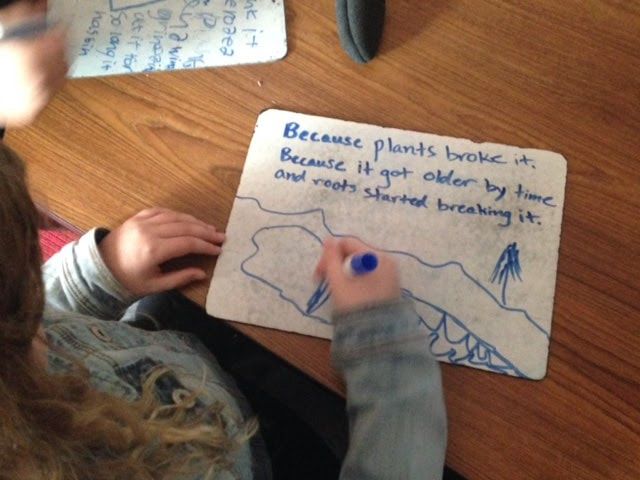


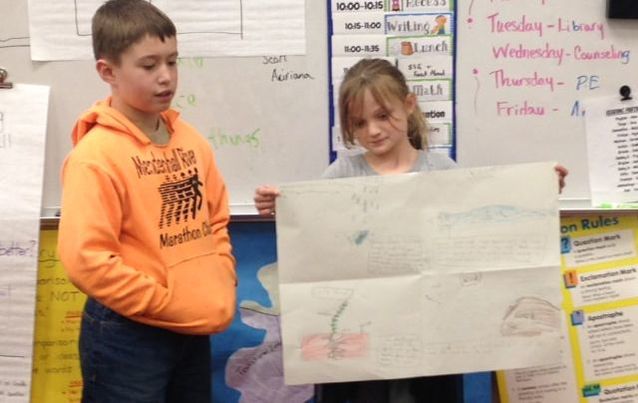

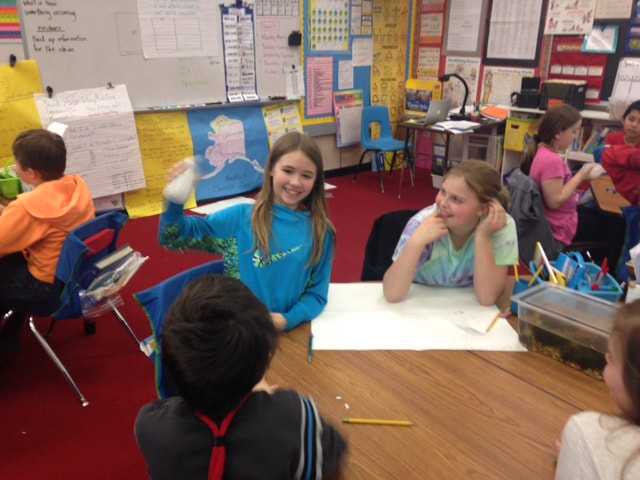

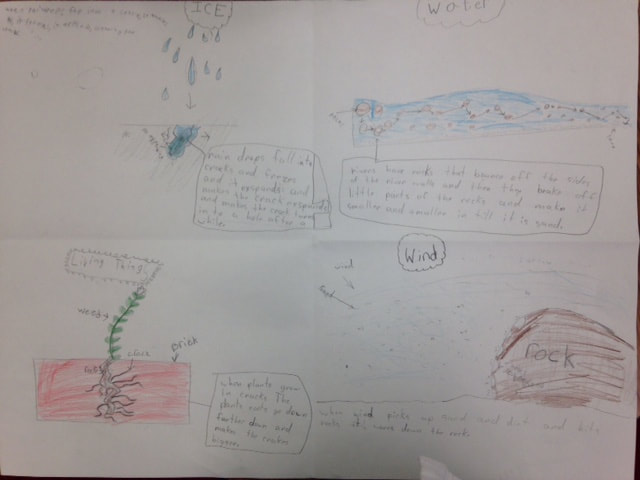





























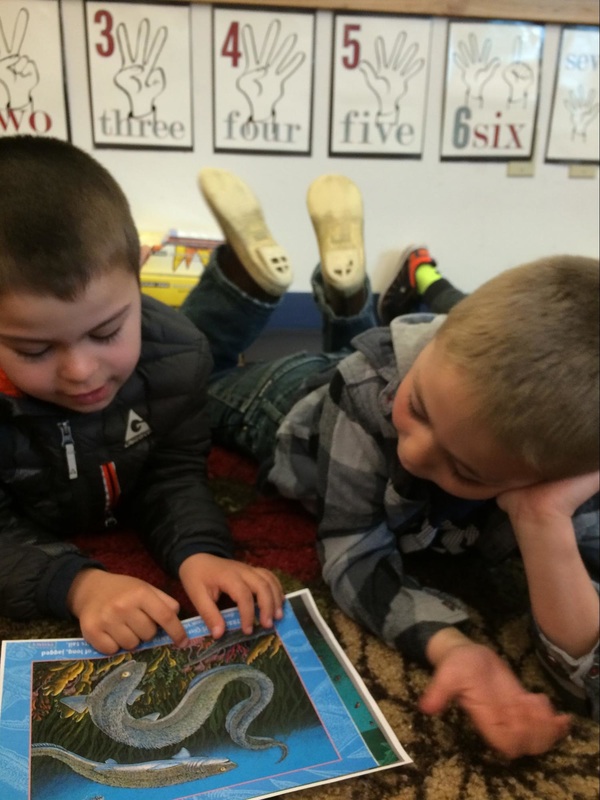












 RSS Feed
RSS Feed